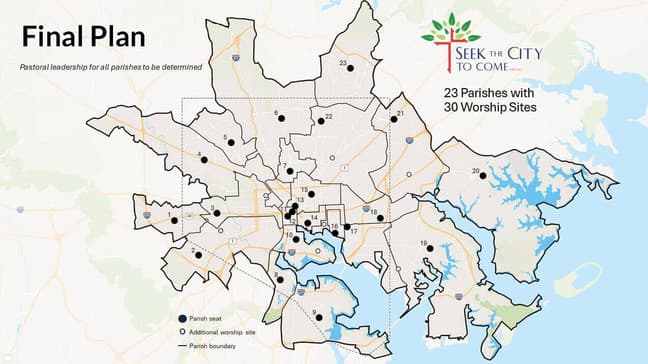NEW YORK – Amid declining numbers and shifting demographics, Archbishop William Lori of Baltimore has finalized a restructuring plan that will cut the 61 parishes at 59 worship sites in the city and surrounding suburbs down to 23 parishes with 30 worship sites.
The changes, which include both church mergers and closures, is the final outcome of the “Seek the City to Come” initiative the archdiocese launched in 2022. A spokesperson for the archdiocese, America’s oldest, told Crux that the number of church closures could reach 29, although some could be repurposed into things like specialty chapels, or be designated as a shrine or a ministry site.
Announcing the final plan, Lori said the decisions “are made with an eye toward a future full of hope.”
“This process was aimed at allowing our parishes to focus on mission and ministry, as opposed to leaking roofs, crumbling walls and failing electric and plumbing systems,” Lori said. “These decisions were made to pull together gifts and resources, often spread thin across many parishes, to form new communities that are well equipped to carry out the mission before us: announcing the Gospel and helping our neighbors here in the city to encounter the saving love of the Father revealed in Jesus Christ.”
“I firmly believe that these mergers will help accomplish this goal, allowing these new parish communities and their pastors to direct the needed material, human and spiritual resources toward that mission,” added Lori, who has led the Archdiocese of Baltimore since 2012.
The 61 parishes involved in the restructuring plan are only a portion of the archdiocese’s 153 parishes and missions. By focusing on parishes involved in Baltimore city and the surrounding suburbs, the archdiocese is addressing an outdated layout based on current population and demographic information.
According to an archdiocese spokesperson, there are about 500,000 Catholics in the Archdiocese of Baltimore, about 14,000 of which (2.8 percent) worship in Baltimore city, and only 5,000-8,000 of which (1-1.6 percent) are city residents. Despite the low percentage of parishioners, the city is home to about a third of the archdiocese’s parishes.
Archdiocese of Baltimore data also shows that church constructions in the city aligned with the meteoric increase of the city’s population from about 1810-1950. Over that time the city’s population grew from about 50,000 to about 900,000, and churches were built to accommodate that growth. However, since 1950 the city’s population has fallen to about 550,000.

In a news release, the archdiocese said that it paid special attention to the population loss in Baltimore city, in particular its ties to racism and disinvestment in Black communities. Therefore, the archdiocese said that it was intentional about keeping parishes planted in storied African American communities. One such historically Black parish in Baltimore, St. Veronica, was recommended to be closed as part of the plan last month, but will now stay open “after hearing the outcry from the parishioners.”
For those that are affected by the final outcome of the initiative, Lori said that some of the mergers will occur in the coming months, while others will continue over the next year or so. Essentially, each parish community will have its own plan that fits its situation. Once the merger processes are complete, Lori said the archdiocese will look to investments in new ministries and buildings.
Lori also clarified that the mergers are not related to the archdiocese’s bankruptcy filing, and that future sales of properties are not to support the bankruptcy settlement. The Archdiocese of Baltimore filed for bankruptcy back in 2023 amid a slew of clergy sex abuse lawsuits. Months earlier, in April 2023, Maryland Attorney General Anthony Brown published a 454-page report that detailed more than 600 instances of child sex abuse by 156 abusers from the archdiocese; the majority of which took place between the 1940s and 2002.
“Many will suspect that these mergers are related to the Chapter 11 Reorganization filing undertaken by the Archdiocese. I assure you; they are not,” Lori said. “I have heard speculation, connecting future sales of properties to supporting the bankruptcy settlement. This is not true.”
“During implementation some properties will be repurposed while some will be sold. Proceeds from any building sale will remain in the parish and follow the people to the newly formed parish,” Lori continued. “This is Church law, and it is supported by civil law.”
Follow John Lavenburg on X: @johnlavenburg















